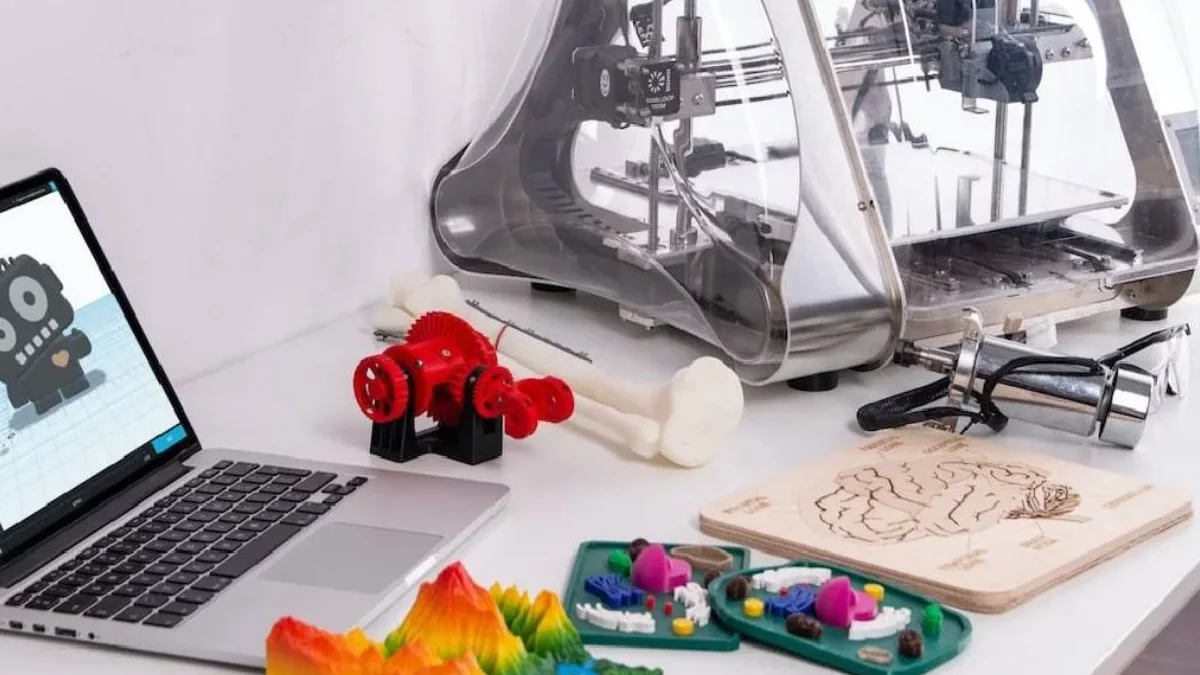Using a 3D printer in these modern times is super-beneficial. 3D printers have recently gained a lot of popularity and attention as people can now understand the full potential of these devices. These printers can be used in an array of applications, as you’ll soon find out by reading this article wholly.
In addition, you’ll also get to understand the following concepts clearly:
- Why using a 3D printer is beneficial
- How 3D printers work step-by-step
- How to maintain your printer like a pro
- Different types of 3D printers and how to select the ideal printer
Let’s dive right in!
Table of Contents
What is a 3D Printer?
First things first – before diving in too deep into the technical bits of a 3D printer, let’s first understand what it is. It is a modern machine that can print different objects regardless of their shapes.
These printers are evidently versatile. They can be used to make almost any object, e.g., ceramic cups and plates, plastic toys, dental parts, and metal precision parts. The list is endless.
You’re probably thinking to yourself:
“How beneficial is a 3D printer?”
Why Using a 3D Printer is Beneficial
There are several advantages associated with using 3D printers. Check them out:
1. Rapid Prototyping
A 3D printer runs using 3D printing software, which we’ll cover in the next section of this article. This software allows you to quickly create prototypes meaning that you get to speed up the completion process of critical parts.
Additionally, you can modify a design countless times until it meets your requirements.
2. Flexibility
3D printers undeniably give a lot of room when it comes to designing flexibility. The 3D printing software allows you to create complex designs. Traditional machines are significantly limited when it comes to flexibility in design.
3. Strong parts
A 3D printer uses 3D printing materials to develop parts. These parts are super strong. The best part about it all is that the parts are lightweight too!
4. Inexpensive
Using a 3D printer saves both time and money. The machine can develop parts quickly (or slowly) depending on the complexity of the parts that you want. Additionally, 3D printers are automated, meaning they do not have to be manned at all times.
The 3D printer is also efficient on 3D printing material (minimal wastage).
How Does a 3D Printer Work?
The functionality of this printer can be broken down into three essential parts:
- 3D printing and slicing software
- 3D printing materials
- A 3D printer’s mechanical function
- 3D Modeling and Slicing Software
3D printers certainly require 3D modeling software, which is used to design prototypes. There are free and premium 3D printing software – some more complex to use than others. More powerful 3D printing software tends to be complex – design experts best handle them.
On the other hand, slicing software is a bridge between a 3D printer and the 3D model designed using 3D modeling software. In other words, 3D slicing software converts a model design into a format that the 3D printer can understand and print – just like computer firmware software.
It is important to note that 3D printers do not share the same 3D printing software. Getting your printer’s software from the printer’s manufacturer would be best.
1. 3D Printing Materials
3D printing materials are simply the materials that a 3D printer uses to print parts. Modern 3D printers can print metal as well as plastic parts. It is, yet again, essential to know which type of 3D printer you have, as different types of 3D printers do not share the same printing materials.
We’ll discuss the types of 3D printers in the coming section of this article.
2. Mechanical Function
Each 3D printer has its unique mechanical function. FDM 3D printers work essentially by forcing out molten plastic (or metal if the printer is strong enough). It extrudes the molten parts through a tiny nozzle which it uses to print parts in layers.
On the other hand, SLA resin printers expose liquid resin that is photosensitive to the printer’s UV laser beam. The liquid resin will then harden according to how you had designed the model.
It is important to note that liquid resin hardens in layers until the intended design is completely printed. This working design enables the printer to produce high-resolution models.
3D Printer Applications
As you read earlier in this article, 3D printers have various applications. Check them out:
1. Healthcare
Advancements in the technology and healthcare industries have shown that this printer can print precision surgical tools, artificial human organs, and joint & bone implants, among others.
2. Creating prototypes and final products
3D printers are well known for creating prototypes and final products. Some of these items include jewelry, shoe designs, toys, etc. You can even go a step ahead to experiment with your own designs, just in case you are a big fan of 3D printers.
3. Architecture
These printers are capable of printing miniature 3D architectural designs. This application of 3D printers is beneficial to building designers and architects because they get to see how the final building will look.
Here’s the deal:
3D printers are not limited to the above three applications. The applications are endless, you just have to know how you’d want to use your 3D printer.
Types of 3D Printers
1. Resin
3D resin printers use an ultraviolet light source to cure liquid resin, meaning that they are capable of high-resolution printing models. Most 3D resin printers have a single-axis motion, meaning their initial acquisition cost is not that expensive.
Selecting the ideal resin printer helps you print high-resolution models quickly and efficiently.
2. FDM
FDM printers work by using thermoplastic filaments as printing materials. The printer produces 3D models by heating the thermoplastic filaments to their melting point. It then extrudes the molten plastic in layers, forming your desired 3D model design.
Again, selecting the ideal FDM printer is crucial as it’ll help you print models quickly and efficiently.
How to Select the Ideal 3D Printer
There are six primary factors to consider when looking for the ideal one. Check them out:
- Look for high-resolution 3D printers: resin printers produce higher resolution models than FDM products. In addition, consider looking for features like dual-filament support, touchscreen UI, heated glass bed, etc., in your desired printer.
- Do you want to print small models or big industrial-size models? It is essential to know what you want to print.
- Your 3D printer should have safety features that will help the printer run more effectively and efficiently. A perfect example is how FDM 3D printers cool their heat beds and nozzle after completing the printing process.
- It is certainly essential to choose your 3D printer brand keenly. A good brand will have great after sales support. You’ll find after sales support extremely beneficial whenever you run into a technical issue, or your printer needs an update on its software.
How to Maintain Your 3D Printer the Right Way
Consider the following nine 3D maintenance tips that will help you lengthen your printer’s lifespan and enable it to work effectively and efficiently:
- Lubricate your 3D printer – lubrication is vital as it helps the mechanical parts of the printer move with ease. However, it is essential to check your printer manufacturer’s guidelines on lubricating the printer correctly.
- Remove dust from the printer and its components – doing so will help do away with buildups that might later harm the printer.
- Get rid of any loose debris after the printing process is complete.
- Clean your 3D printer’s nozzle often to eliminate leftover plastics after the printing process is complete.
- Ensure that your printer does not overheat during printing. Overheating could be a sign that your printer has a lot of stress.
- It would be best to ensure that the printer’s belts are tight. Loose belts will undoubtedly affect the performance of your 3D printer.
- Replace worn-out parts with new parts from your printer’s manufacturer.
- Place your printer on level ground during printing.
- Keep your printer’s firmware up to date – this can only be achieved by choosing an excellent 3D printer brand.
Final Thoughts
As 3D printers continue gaining popularity across different industries, selecting the ideal printer is essential. Knowing what you want to print and how well you want the printed model to look will dictate which type of printer you’ll get.
It is also essential to take care of your 3D printer by maintaining it. Remember, different 3D printers use different printing materials.
Related posts
Recent Posts
Streamline Your Workflow: Remove Object from Photo Quickly
Introduction: Remove Object from Photo: In the fast-paced world of photography, efficiency is key. Every photographer strives to streamline their…
Retained Domain: Why You Should Renew Your Web Address
Retained Domain: For business owners who are new to the domain name game it’s important to know that they will…



